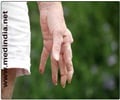A new study by researchers at the University of Melbourne has revealed that using a cane might reduce the risk of knee osteoarthritis (OA) progression, a common, incurable joint disease,
Researchers at the University of Melbourne have revealed that using a walking stick may reduce the risk of knee osteoarthritis (OA) progression. The latter is a common, incurable joint disease, and happens to be the leading cause of disability in seniors.
Although nearly any joint can be affected, OA most often strikes the knee, particularly the inner aspect of the tibiofemoral joint. One source of stress on this vulnerable joint compartment is the knee adduction moment, an indication of weight placement while walking.A 20 percent increase in the peak knee adduction moment is linked to a 6-fold or greater increase in the risk of knee OA progression over 6 years.
To decrease knee load, pain and damage in knee OA patients, doctors often recommend two inexpensive interventions: footwear and cane use.
These simple strategies have the potential to alter the knee adduction moment, but there is little research attesting to their specific benefits for knee OA sufferers.
In order to assess the immediate effects of walking shoes and a walking cane on the peak knee adduction moment in people with knee OA, researchers turned to 3-dimensional (3-D) gait analysis.
The results strongly support using a cane on a regular basis to reduce the load borne across the knee, while underscoring the urgent need for studies into which aspects of shoe design best support the treatment of knee OA patients.
Advertisement
All participants had medial tibiofemoral osteophytes, as well as knee OA symptoms such as persistent knee pain and loss of physical function. None had a history of joint replacement. The group's mean body mass index was 29.6 and mean age was 65 years.
Advertisement
Embedded in the test area walkway, and unknown to participants, two force plates captured ground impact. Reflective markers, strategically placed on the pelvis, thigh, knee joint, and foot, captured limb movement.
All participants were tested first in bare feet, followed immediately by testing in their own shoes, a comfortable pair typically used for walking.
Researchers further tested 20 of the participants wearing their own shoes and using a cane in the opposite hand to the study knee, after a brief instruction in ideal cane use by a physiotherapist.
Data from 5 successful trials were collected for each test. A mean score was used to calculate changes in gait parameters and determine the peak knee adduction moment.
Researchers found that overall, the peak knee adduction moment when walking in shoes was significantly higher than when walking barefoot.
However, the effect of footwear varied considerably among individuals.
While most showed an increased knee adduction moment while wearing shoes, 6 of the 40 subjects actually demonstrated a beneficial decrease.
Researchers found that the use of a cane resulted in a striking 10 percent average decrease in the knee adduction moment. A quarter of the participants demonstrated a reduction of more than 20 percent.
While individuals tended to walk more slowly with the cane than unaided, they exhibited greater stride length and improved pelvis control, alleviating the destructive load on the affected knee.
Though canes are widely recommended to knee OA patients, this study validates their therapeutic value, at least in the short-term.
The study is published in the May 2008 issue of Arthritis Care and Research.
Source-ANI
RAS/L











